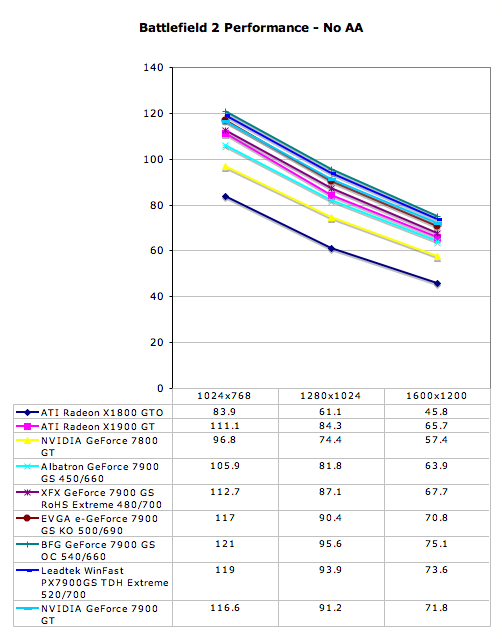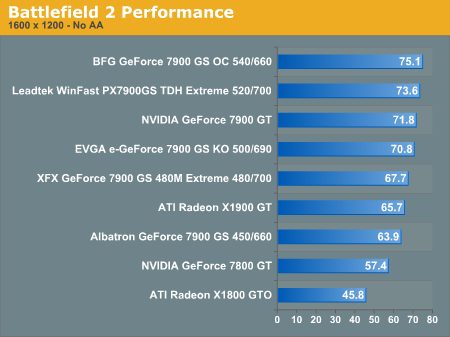The NVIDIA GeForce 7900 GS: A Closer Look
by Josh Venning on September 19, 2006 5:00 AM EST- Posted in
- GPUs
Test Setup
We already had a look at how the 7900 GS performs relative to several other cards currently on the market from both ATI and NVIDIA. Today we will be looking at how well these individual 7900 GSs perform relative to each other, and we've thrown in a couple of other cards from NVIDIA and ATI for reference. From NVIDIA, we included the reference 7800 GT and the 7900 GT, and from ATI, the X1900 GT and the X1800 GTO.
We tested three different games at three different resolutions to give us a general idea of performance. The games we tested were Battlefield 2, Half-Life2:Episode One, and The Elder Scrolls IV: Oblivion. We tested each of these games at 1024x768, 1280x1024, and 1600x1200 with graphics quality settings on high in each game whenever possible.
This is the system we used for testing:
*Note that sound was disabled for testing.
Battlefield 2
We start our performance tests by looking at Battlefield 2, one of our standard game benchmarks. This benchmark is basically a running game demo following several players in different vehicles (including a jet) and on foot in third-person view. This gives us samples from different perspectives in the game and provides a good overview of the performance in Battlefield 2. Detail settings are on "High" for testing.


The five 7900 GS samples we have here offer a good representation of the performance potential this card has with different factory overclocks from card manufacturers. The "out of the box" performance of the 7900 GS will vary more or less depending on the game between different card versions. In Battlefield2, we see a significant difference between performance between the slowest 7900 GS (the Albatron GeForce 7900 GS) which is clocked at reference speeds, and the higher clocked BFG GeForce 7900 GS OC. At 1600x1200 resolution, there is a 17.5% framerate increase with the overclocked BFG 7900 GS, which could definitely be a noticeable improvement during gameplay.
Also, we can see how at reference speeds, the 7900 GS gets lower framerates than the reference 7900 GT, but most of our factory overclocked 7900 GS cards match or surpass the performance of the 7900 GT in each resolution. This is important considering that the 7900 GT generally costs around $100 more than the 7900 GS. Keep in mind however, that the 7900 GT has potential for overclocking as well, and its performance potential will exceed that of the 7900 GS depending on the specific card and application.
Something else we see that is particularly noteworthy here and in the other game tests is how ATI's X1900 GT compares to these 7900 GS cards in performance. The 7900 GS at reference speeds doesn't perform as well as the X1900 GT; for example, at 1024x768 the Albatron 7900 GS gets a framerate of 105.9 FPS verses the X1900 GT's 111.1 FPS. But as we saw in the previous example, our Leadtek and BFG 7900 GS samples get higher performance with their factory overclocks, which is of interest given these cards are in direct competition with each other.
We already had a look at how the 7900 GS performs relative to several other cards currently on the market from both ATI and NVIDIA. Today we will be looking at how well these individual 7900 GSs perform relative to each other, and we've thrown in a couple of other cards from NVIDIA and ATI for reference. From NVIDIA, we included the reference 7800 GT and the 7900 GT, and from ATI, the X1900 GT and the X1800 GTO.
We tested three different games at three different resolutions to give us a general idea of performance. The games we tested were Battlefield 2, Half-Life2:Episode One, and The Elder Scrolls IV: Oblivion. We tested each of these games at 1024x768, 1280x1024, and 1600x1200 with graphics quality settings on high in each game whenever possible.
This is the system we used for testing:
| CPU: | Intel Core 2 Extreme X6800 (2.93GHz/4MB) |
| Motherboard: | Intel D975XBX (LGA-775) ASUS P5NSLI |
| Chipset: | Intel 975X NVIDIA nForce 570 SLI |
| Chipset Drivers: | Intel 7.2.2.1007 (Intel) NVIDIA nForce 8.22 |
| Hard Disk: | Seagate 7200.7 160GB SATA |
| Memory: | Corsair XMS2 DDR2-800 4-4-4-12 (1GB x 2) |
| Video Card: | Various |
| Video Drivers: | ATI Catalyst 6.8 NVIDIA ForceWare 91.47 |
| Desktop Resolution: | 1920 x 1440 - 32-bit @ 60Hz |
| OS: | Windows XP Professional SP2 |
*Note that sound was disabled for testing.
Battlefield 2
We start our performance tests by looking at Battlefield 2, one of our standard game benchmarks. This benchmark is basically a running game demo following several players in different vehicles (including a jet) and on foot in third-person view. This gives us samples from different perspectives in the game and provides a good overview of the performance in Battlefield 2. Detail settings are on "High" for testing.


The five 7900 GS samples we have here offer a good representation of the performance potential this card has with different factory overclocks from card manufacturers. The "out of the box" performance of the 7900 GS will vary more or less depending on the game between different card versions. In Battlefield2, we see a significant difference between performance between the slowest 7900 GS (the Albatron GeForce 7900 GS) which is clocked at reference speeds, and the higher clocked BFG GeForce 7900 GS OC. At 1600x1200 resolution, there is a 17.5% framerate increase with the overclocked BFG 7900 GS, which could definitely be a noticeable improvement during gameplay.
Also, we can see how at reference speeds, the 7900 GS gets lower framerates than the reference 7900 GT, but most of our factory overclocked 7900 GS cards match or surpass the performance of the 7900 GT in each resolution. This is important considering that the 7900 GT generally costs around $100 more than the 7900 GS. Keep in mind however, that the 7900 GT has potential for overclocking as well, and its performance potential will exceed that of the 7900 GS depending on the specific card and application.
Something else we see that is particularly noteworthy here and in the other game tests is how ATI's X1900 GT compares to these 7900 GS cards in performance. The 7900 GS at reference speeds doesn't perform as well as the X1900 GT; for example, at 1024x768 the Albatron 7900 GS gets a framerate of 105.9 FPS verses the X1900 GT's 111.1 FPS. But as we saw in the previous example, our Leadtek and BFG 7900 GS samples get higher performance with their factory overclocks, which is of interest given these cards are in direct competition with each other.










42 Comments
View All Comments
sum1 - Friday, September 22, 2006 - link
It’s listed at 540MHz everywhere else in this article (including the benchmarks).I posted this discrepancy twice, days ago, hasn’t anyone else noticed yet?
Josh Venning - Saturday, September 23, 2006 - link
It's been fixed. Thanks for pointing this out, and we apologize for not fixing it sooner.PerfectCr - Thursday, September 21, 2006 - link
Fan Noise? How do I know how loud/quiet the fans are? Do they throttle?kmmatney - Tuesday, September 19, 2006 - link
Its interesting how the XFX card (the only RoHS card - uses less lead and other hazardous chemicals) uses more power. I wonder if this will be true of other RoHS devices.yyrkoon - Wednesday, September 20, 2006 - link
I can tell you that the motherbord I use, which is also RoHS 'certified' (Asrock AM2NF4G-SATA2) runs pretty dahmed cool (sub 95F, when ambient is 80F ish), doesnt even use active cooling for the chipset etc either. Reguardless, if its the actual cause or not, I think its well worth it in the long run.Zaitsev - Tuesday, September 19, 2006 - link
On page 3 third line, "NVIDIDA intends for it to be a direct competitor to ATI's X1900 GT"Zaitsev - Tuesday, September 19, 2006 - link
Sorry, that should be page 2.Josh Venning - Tuesday, September 19, 2006 - link
fixed, thanksHoward - Tuesday, September 19, 2006 - link
I believe the bar is there to reduce PCB bending under weight.DerekWilson - Tuesday, September 19, 2006 - link
It's possible I suppose ... but it seems to me that you'd want to attatch the bar to the pcb at more than two points if this is the case. And you might also want to connect it to the slot cover for the added support of the case screw. Granted, I'm not a mechanical engineer, but it seems to me that connecting one part of the pcb to another like this would just move any moment created by the weight of the HSF somewhere else on the pcb.I've also never seen a graphics board bend under normal use. Intel motherboards are another story though. :-)
Whether or not its made for this, I do have a good use for it: having this bar makes it easier to find a place to grab when removing the card. Sometimes it's tough to find a spot on the pcb to grab, and sometimes the HSF solution isn't mounted in such a way that it's stable enough to use either (I distinctly remember the 6600 GT really disliking any contact with the HSF). This doesn't apply to the huge heat-sink-is-bigger-than-my-forearm solutions though -- they're usually bolted on pretty tight.